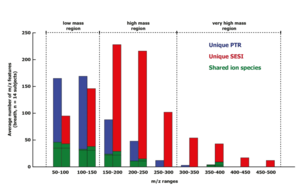Detection of VOCs with Secondary Electrospray Ionization and Proton Transfer Reaction High-Resolution Mass Spec.: A Feature Comparison
Tobias Bruderer, Martin Thomas Gaugg, Luca Cappellin, Felipe Lopez-Hilfiker, Manuel A. Hutterli, Nathan Perkins, Renato Zenobi, and Alexander Moeller.
Abstract: The analysis of volatiles is of high relevance for a wide range of applications from environmental air sampling, security screening to potential medical applications. Highresolution mass spectrometry methods offer a particular wide compound coverage, sensitivity and selectivity. On-line approaches allow direct analysis in real time without the need for sample preparation. For the first time, we systematically compared the analysis of volatile organic compounds with Secondary Electrospray Ionization (SESI) and Proton Transfer Reaction (PTR) high-resolution mass spectrometers. The selected instruments had comparable mass resolving power with 15’000 m/Δm or higher, which is particularly suitable for nontargeted analysis, for example, of exhaled breath. Exhalations from 14 healthy adults were analyzed simultaneously on both instruments. In addition, 97 reference standards from nine chemical classes were analyzed with a liquid evaporation system. Surprisingly, in breath, we reported more complementary than overlapping features. A clear mass dependence was observed for each method with the highest number of detected m/z features for SESI in the high mass region (m/z = 150 – 250) and for PTR in the low mass region (m/z = 50 – 150). SESI yielded a significantly higher numbers of peaks (828) compared to PTR (491) among a total of 1304 unique breath m/z features. The number of signals observed by both methods was lower than expected (133 features) with 797 unique SESI features and 374 unique PTR features. Hypotheses to explain the observed mass-dependent differences are proposed.


